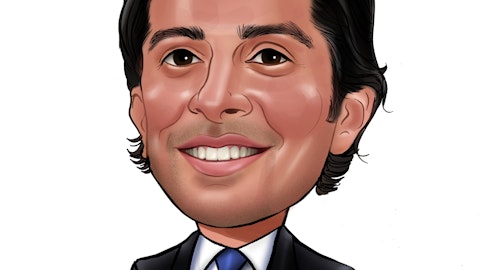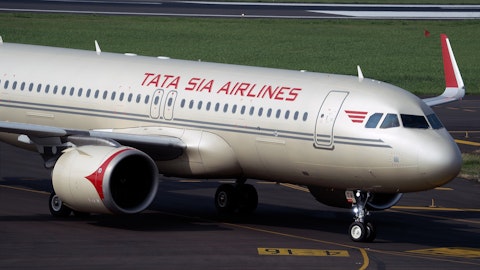Yatra Online, Inc. (NASDAQ:YTRA) Q3 2023 Earnings Call Transcript March 28, 2023
Operator: Hello, and welcome to the Yatra Fiscal Third Quarter 2023 Financial Results Call. My name is Alex, and I’ll be coordinating the call today. I will now hand you over to the host, Manish Hemrajani, Head of Investor Relations. Please go ahead.
Manish Hemrajani: Thank you, Alex. Good morning everyone. Welcome to Yatra’s fiscal third quarter 2023 financial results for the period ended December 31, 2022. I am pleased to be joined on the call today by Yatra’s CEO and Co-Founder, Dhruv Shringi; and the CFO, Rohan Mittal. The following discussion, including responses to your questions, reflects management views as of today, March 28, 2023. We don’t undertake any obligation to update or revise the information. Before we begin our formal remarks, allow me to remind you that certain statements made on today’s call may constitute forward-looking statements, which are based on management’s current expectations and beliefs and are subject to several risks and uncertainties that could cause actual results to differ materially.
For a description of these risks, please refer to our filings with the SEC, and our press release filed earlier this morning. Copies of this and other filings are available from the SEC, and also on the Investor Relations section of our Web site. With that, let me turn the call over to Dhruv. Dhruv, please go ahead.
Dhruv Shringi: Thank you, Manish. Good morning, everyone, and thank you for joining us today for our third quarter earnings call of fiscal ’23. Before we discuss our results for the quarter, let me first provide you with an update on our ongoing India IPO process. As you may recall, our Indian subsidiary, Yatra Online Limited, filed a Draft Red Herring Prospectus just about a year ago, on March 25, 2022, with the Securities and Exchange Board of India. SEBI has issued the final observation letter dated November 17, 2022 to Yatra, which means that Yatra India’s proposed initial public offering can open for subscription within 12 months of that date. We commenced our India investor outreach, the India roadshows in earnest at the beginning of the March quarter.
We met with a number of marquee investors in India, including large domestic mutual funds, family offices and hedge funds who are focused on the Indian market. Our story has been well-received given the strong underlying performance, the strong recovery in both consumer and corporate travel in India, and favorable macro trends for sustained long-term growth which are supported by the government prioritizing the infrastructure spending in the aviation sector. However, given the overall macro environment and the global market sentiment, the investor feedback process has taken longer than expected, but the key investors continue to remain engaged with us. And we are hopeful and confident of getting the IPO done in the near-term. Switching tracks to the macro for business environment.
In the December quarter, domestic aviation witnessed a strong recovery with air passenger traffic up 17% year-over-year, and 19% q-on-q. The Indian government remains committed to growth in this sector by way of infrastructure spending on new airports and expansion of existing airports. Under the UDAN scheme launched by the government in October 2016, more than 425 new air routes have been commenced to date, with plans to take that number to 1,000 by 2026. The number of operational airports have also grown in the last five years, from 74 to 141. And the government plans to have 220 airports operational by 2026. Last month, the now privatized Air India placed two mega orders, one with Airbus, and the other with Boeing, adding up to 470 aircrafts.
70 of these are for wide-body aircrafts and double-aisle planes which are going to be used for long haul international travel, and 400 are for narrow-body single-aisle aircrafts to be used for domestic and near shore destinations. Air India’s current fleet size, of approximately 115, nearly quadruples on the back of this order. And that takes the expected number of planes in India to grow by over 2.5 times from the approximate 700 planes at the moment to almost 1,700 planes by 2027. The outlook for aviation market in India remains very favorable. And we expect that a long period of sustained growth on the back of these initiatives. India’s domestic traffic has now grown to about 2% of the overall world share, from 1.6 per-COVID, but still remains well below China’s 6.4% world share, which suggests that there are multiple years of growth ahead of us as we get into a similar environment as China over the next few years.
India’s hotel industry too turned in a stellar 2022 with revenue per available room, our RevPAR recovered to pre-COVID levels despite a slow start to the year 2022 caused by a surge in the Omicron variant. Anecdotally, if you look at the results of some of the large hotel chains, they have posted some of their best quarterly results in a very long time in the December quarter. We see that domestic occupancy levels and RevPAR have all now surpassed pre-COVID levels, with corporate momentum stronger than leisure compared to pre-COVID. From a macro standpoint, the IMF predicts India’s GDP to grow at about 6.8% in fiscal 2023. As we have mentioned previously, the travel industry has historically grown at approximately 1.5 to 2x GDP growth in developing markets.
We continue to believe that we should be able to achieve growth above market rates driven by share gain in the corporate travel market and the ongoing secular shift from offline to online in the consumer market. Given the ongoing recovery in corporate and leisure travel, our continued success in signing new large and midsized enterprise customers, we believe we are poised for a strong calendar 2023. Aside from seasonality, we expect our results to benefit from accelerating growth in our corporate business as we continue to add to our blue chip customer base. Just to reiterate, today, Yatra India serves one out of every four of the top 100 listed companies in India. We service three of the big four accounting firms, and we service three of the top five technology companies in India.
Indeed, an enviable client base. Now on to our fiscal Q3 results, I am pleased to report that we delivered strong year-over-year growth of 43% in adjusted revenue, driven by recovery in both our consumer and corporate travel business. The recovery was on account of the domestic travel market in India rebounding back to pre-COVID levels, along with the onboarding of new corporate customers in our corporate business. In fiscal year ’23, we have signed a record number of over 72 medium to large corporate customers in the first nine months of this fiscal year as the travel recovery has gained momentum. Our revenue and adjusted revenue for the quarter came in at INR 902 million which is approximately $11 million and INR 1,489 million, which is approximately $18 million respectively.
So, revenue closed to $11 million in the quarter and adjusted revenue close to about $18 million in the quarter respectively. Marginal decline in adjusted revenue by 1.7% sequentially was on account of seasonality in our corporate business. The December quarter typically is the slowest quarter for the corporate business because of the large number of holidays both on account of Diwali, which happens in October and then Christmas towards the year-end. Adjusted EBITDA for the quarter came in at INR 36 million, approximately $400,000. The decline in adjusted EBITDA by INR 8 million is due to higher legal and professional services costs, mainly relating to increased compliance costs year-over-year. Our consumer business remains strong on the back of the holiday season and strong growth in the aviation industry.
Overall, domestic air travel industry volumes expanded by around 19% in the third quarter. Domestic travel ended surpassing pre-COVID levels as well in the current quarter. We also saw continued strength in new corporate customers with 72 new signings in the first nine months, and the December quarter, as we said has been a lean quarter given the nature of the industry. International travel continued to improve during the quarter ended December. This is following the easing of international travel restrictions and reached approximately 88% of pre-COVID levels. With the lifting of all travel restrictions in the Asia-Pacific region, which has lagged the global recovery in international travel, we are now optimistic in the outlook for a sustained recovery in nearshore international travel as well.
On account of the above factors, our adjusted air revenue was up 39.2% year-over-year with air gross bookings up 37% year-over-year. On the hotel front, our adjusted revenue was up 21% year-over-year with standalone room nights up 16%. Please do note that our standalone hotel room nights were up 33% compared to standalone hotel room nights in the pre-COVID era of 2019. This is on account of the hotel business continuing to benefit from stronger corporate demand as more and more corporates come under the managed hotel program and our partnership with Flipkart owned theater. Packages grew 41%, albeit from a small base as seasonality played its part in the December quarter. On the liquidity front, as of December 31, the balance of cash and cash equivalents and term deposits on our balance sheet was INR 1,083 million, which is approximately $13.1 million and this is an increase of INR 380 million or $4.6 million versus the September quarter.
During the three months ended December, we raised debt of INR 300 million for the purpose of meeting our working capital requirements. This was raised from a non-banking financial corporation in India and subsequent to the end of the quarter, we have been sanctioned secured sales invoicing and working capital facilities to the tune of INR 902 million from domestic Indian banks taking our total facilities in place in India to INR 1,452 million versus a pre-COVID level of INR 1,300 million. With these facilities in place, we believe our balance sheet is strong and we are adequately capitalized and have sufficient working capital financing facilities in place to continue to fund the robust growth in our corporate business and be in a position to repay any obligations that come up in the later part of the year.
Given that we are almost at the end of the March quarter, we thought it would also be proven to share some preliminary expectations for the March 2023 quarter, a record high number of Indians traveled by domestic air per day on an average in February 2023, surpassing the previous high of November 2019. On average, 431,000 people traveled in domestic flights per day in February. This was up 6.5% from January and higher than the previous record of 430,000 in November 2019. Based on such quarterly trends to date, we anticipate an adjusted revenue range of INR 1,650 million to INR 1,700 million, which is approximately $19.5 million to $20.5 million for the March 2023 quarter. And this would translate to a sequential growth rate of between 10% and 14% on a Q-on-Q basis and also make the March quarter our strongest quarter since the start of COVID.
In addition, during the March quarter, our Indian subsidiary Yatra Online Limited also set up our wholly owned subsidiary in Dubai. The objective of this subsidiary is to focus on expanding our software platform for corporate travel to customers in the Middle East and Africa. With that, let me hand you over to Rohan to walk you through the details of the financial performance. Rohan?

Photo by sabina fratila on Unsplash
Rohan Mittal: Thank you, Dhruv. I will now review our December quarter results and focus primarily on year-on-year YoY comparisons. Our adjusted revenue increased by 42.5% YoY to INR 1.49 billion. The strong YoY growth was driven by a rebound in the air passenger traffic by 17% YoY and an improvement in the yields which resulted in a 39.2% increase in air ticketing adjusted revenue to INR 1.01 billion. Adjusted revenue for hotels and packages was also up by 21% to INR 254 million. Our other revenue was posted at INR 129.3 million in the December quarter, an increase from INR 52.5 million in the year-ago quarter due to increase in advertising revenue. Total gross bookings increased by 33.4% YoY to INR 15.8 billion, reflecting the normal seasonality.
Hotel and packages gross bookings also improved 57% YoY reflecting the strength in our corporate uptake of hotels as well as a 41% volume growth in packages. Gross air passengers booked were 1.32 million, up 4.2% on a YoY basis, while the standalone hotel room nights booked were 398,000 up by 16.3% YoY. Moving on to the expenses, marketing and sales promotion expenses including ad back for consumer promotions and loyalty program costs increased by 53% on a YoY basis to INR 820.9 million. Our personnel expenses increased by 22.9% to INR 311.6 million, which is about $3.8 million in the three months ending December 31, 2022 from INR 253.4 million in the previous year same quarter. Excluding the employee share-based compensation costs of INR 54.5 million in the three months ending December 31, 2022, compared to INR 49.6 million in the previous year same quarter.
Personnel expenses increased by 26.1%, this is due to the impact of the reinstatement of salaries for employees to pre-pandemic levels and annual salary increase along with increase in headcount. Other operating expenses increased by 43.5%, which is in line with the adjusted revenue growth to INR 374.8 million versus INR 261 million in previous year same quarter. This was primarily due to the increase in commission, legal and professional charges and payment gateway charges, rates and taxes, and provision for doubtful receivables. As of December 31, 2022 we had a cash balance, cash and cash equivalent balance of more than INR 1 billion, a little around USD 13.1 million, which was an improvement over the previous quarter closing of INR 703 million.
This concludes our prepared remarks; handing back to Manish. Thank you.
Manish Hemrajani: Thanks, Rohan. Alex, you can now open up the call for Q&A. Thank you.
See also 16 Largest Grocery Chains in the World and 15 States with the Largest Declines in Unemployment.
Q&A Session
Follow Yatra Online Inc.
Follow Yatra Online Inc.
Operator: Thank you. Our first question for today comes from Scott Buck of H.C. Wainwright. Scott, your line is now open. Please go ahead.
Scott Buck: Hi, good morning, everybody. Thank you for taking my questions. First one, hoping you could give us a little more color on some of the market share gains on the corporate side, and maybe talk a little bit about what the ongoing opportunity is there?
Dhruv Shringi: Sure, Scott. Good morning. On the corporate side, as we’ve shared, we won 72 customers in the first nine months of the year. The customer base that we’re winning are more towards the mid and the larger end of the market. And what we are seeing today is that there is an increased awareness on the part of the organizations to adopt technology. And given that we are the market leaders, we continue to see a strong pipeline on people wanting to adopt technology to service their business travel needs. We’ve also seen some share shift gains happening in some of our larger customers, and we are confident that that will continue to accelerate as well. In terms of the market opportunity, today, while we are servicing close to about 770-plus customers, the market itself is about 1,300 large corporate customers.
So, there is enough and more headroom for growth for us as we tap into just this first level of mid-to-large scale corporate customers. While pre-COVID, the bulk of our demand for technology adoption would either come from the consulting firms or the software development companies which had a more younger and more agile workforce, what we’ve seen off late is that even the old-school Indian manufacturing companies have now looked at adopting technology as companies focus on trying to get to terms with the new hybrid working environments. So, we are seeing a strong resurgence happening, and the market suddenly growing from just being the MNC/the large consulting firms to the Indian large corporations also wanting to adopt technology at a brisk pace now.
Scott Buck: Great, that’s helpful. And then, Dhruv, are you guys seeing any softening in corporate travel due to — or, I’m sorry, I should say any impact on corporate travel due to some of the softening macro environment or between market share gains and recovery that’s all being offset?
Dhruv Shringi: Scott, even in terms of same customer spends; we are not really seeing any slowdown at this point. The market in India is quite buoyant, demand continues to be strong, and there is enough and more growth happening, and business happening in the Indian environment. See, if you look at even the growth data that IMF puts out, it’s anywhere between 6.5% to 7% kind of growth rate for the economy as a whole. So, we are not seeing a slowdown of economic activity in India. There might be one or two pockets which really heavily export focused; those might be witnessing some slowdown. But the overall growth in the market continues to be very robust at the moment as we’ve witnessed on the back of what we’ve seen on the aviation demand, right?
As I just articulated in February, we crossed the highest number of domestic air passengers traveled ever. Likewise, hotels have been reporting occupancy and RevPAR rates that they’ve never really witnessed in a very long time. So, economic activity in the country continues to remain very buoyant at this point, and we’re not seeing any signs of a slowdown.
Scott Buck: That’s great. And then last one for me, it looks like personnel expenses were up a bit sequentially. Can you talk about any hiring you’ve been doing or may need to continue to do on that front, and how it could impact OpEx?
Dhruv Shringi: Sure. So, personnel expenses sequentially moved up only marginally. Year-over-year, there was a bigger jump. The year-over-year jump is also because last year, so this is now 2021 October, November, December that we are referring to; a large part of the working population in Yatra was still at reduced salary levels. And salaries only began to get reinstated towards the middle of 2022. So, there is some effect of that base effect coming through when it comes to salary cost. In terms of incremental costs from here, while there will be annual inflationary cost increase, which is there. In terms of headcount, we might add one or two more people in the senior team. But beyond that, the most significant number of people which will get added will be more at the operating level.
So from a weighted average cost point view, it’s not going to have a large impact on the overall cost structure of the organization. It’s going to be much more towards the front end and frontline staff which is there to service the corporate demand as we go into more and more corporate and we go through a transition process with them as they adopt technology, there is some manual servicing effort also which is there. So, it’s going to happen more at that end, and hence should not have a meaningful impact on our overall cost structure.
Scott Buck: Great, that’s very helpful. I appreciate the time, guys. Thank you.
Dhruv Shringi: Sure, thank you.
Operator: Thank you. Our next question comes from Anja Soderstrom from Sidoti. Anja, your line is now open. Please go ahead.




